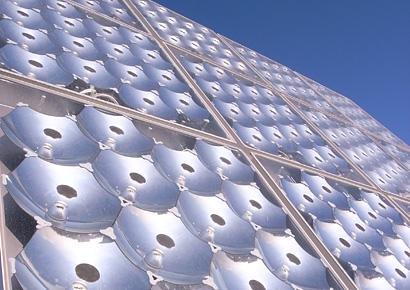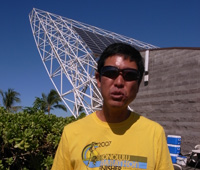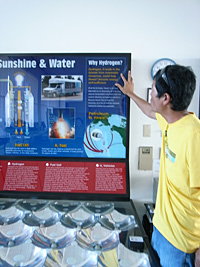
from US vol. 43 2009.01.15 Hawaii's commitment to establishing a sustainable hydrogen economy
![]()
Most people think of Hawaii as a very popular tourist destination, but its main source of income - tourism - is in decline due to rapid fluctuations in the oil prices and economic depression on the mainland. It is also reliant on imports of various goods. So for Hawaii to become sustainable, it is imperative that it becomes self-sustaining in terms of food and energy. Amid such uncertain circumstances, Hawaii has begun to concentrate its efforts in developing a new industry that may replace tourism. It has begun to put in place infrastructure that will help create a society that relies on renewable energy such as geothermal heat, wind and hydraulic power and hydrogen rather than fossil fuels. There are high hopes to apply hydrogen created by renewable energy available in great abundance in Hawaii as fuel for next generation cars and for sustainable farming. "Shift towards a hydrogen economy" has become a real topic for Hawaii, which has even been clearly mentioned in state legislation. I went and spoke to a few key persons involved in this shift to a hydrogen economy, and learned that this was not a mere pipe dream.
Back to Table of Contents The Big Island, Hawaii, is the "Earth's belly button"
 Guy lives on the Big Island and works at H2 Technologies Inc.
Guy lives on the Big Island and works at H2 Technologies Inc.
Hawaii is located in the middle of the Pacific, and forms the northern edge of the Polynesian triangle. It is known as a tourist destination (famous for, for example, Waikiki Beach, etc.), but it is also well known as a spiritual spot with an abundance of natural energy. And on the Big Island, you will find H2 Technologies, a company conducting business that will help form a hydrogen economy. H2 Technologies is a very important business partner for biopio inc., a company that runsgreenz.jpwhere I work as a creative director. Because it shared the vision of creating a hydrogen economy, H2 Technologies is promoting a project that brings Japan and Hawaii together through "Meetings for the Future" held regularly to provide a platform for exchanging information.
Mr. Guy Toyama the Chief Operating Officer of H2 Technologies strongly asserts that "hydrogen economy is not something for the distant future. The time is ripe for making it happen." This trip to Hawaii was very invaluable as I learned about activities undertaken in and by Hawaii, which hopes to make effective use of its rich natural environment and to serve as a role model for the rest of the world. I became convinced that such an economy could indeed be realized.
Back to Table of Contents The Big Island is full of energy
 The eastern side of the island, Hilo side, is covered in dense jungles.
The eastern side of the island, Hilo side, is covered in dense jungles.
You can drive around the Big Island in about 6 hours, but you will be quite blown away by how variegated the scenery is. It changes from molten lava, beaches, jungles, to dry mountains. Eleven out of the 13 types of climatic divisions are said to be found on the Big Island (2 that it doesn't have are desert and arctic climates). Tall mountains, whose peaks are covered in snow during the winter, divide the clouds above in half, right down the middle of the island. And as a result, Kona on the west with all the resorts is dry all the time and Hilo on the east is always rainy, so you can see rainbows almost every day.
 The early morning sunlight from the peak of Mauna Kea - a 4,000m climb in a car.
The early morning sunlight from the peak of Mauna Kea - a 4,000m climb in a car.
The 2 mountains aren't so daunting tall. But Mauna Kea, which has an altitude of 4,205m, is a sacred place for the indigenous people. It is also known as a the best place in the northern hemisphere to look at stars; stars seen from the top the mountain are absolutely beautiful, so astronomical observatories of many countries, including Japan are located on the mountain top. Although I said it wasn't so daunting, if you measure its height from the bottom of the Pacific Ocean, its altitude measures more than 10,000! Mauna Loa, on the other hand, is where carbon dioxide analyzers have been set up, and it has an altitude of 4,169m. And it is said to have the second greatest cubic volume in the solar system, next to Mount Olympus on Mars with an altitude of 25,000m.
The guide explained that "the magma underneath tried really hard to find a way out, and it finally found one here on the Big Island." The natural environment on this island, where the Kilauea volcano is still very active, is really monumental in scale. This sublime power is believed to be bound to "mana" the sacred power believed to be present in nature, and I realized that it formed the bedrock of Hawaii's environmental protection activities and energy policies.
Back to Table of Contents Energy in Hawaii and investing in the future
Although there are great things about Hawaii, it fraught with challenges. The biggest challenge is overcoming its external dependence on energy.
Back to Table of Contents Petroleum puts a squeeze on household finances
According to Guy, although Hawaii has no fossil fuels such as petroleum, natural gas or coal, 90% of the energy used in Hawaii is dependent on petroleum of which 71% is imported from outside the US. This figure is the highest among all American states.
 Roads in Oahu are always crowded.
Roads in Oahu are always crowded.
According to the state survey from 1997, Hawaii purchases 1 billion dollars (100 billion yen) worth of petroleum. 26% of the oil purchased goes into making electricity, and 55% into transportation/shipping by land/sea/air. As there are no railroads in Hawaii, there are 900,000 cars in Hawaii, and there's always traffic near Honolulu. And in general, gasoline prices are 25% higher than on the mainland, so my wallet was feeling the pain from all that driving around the island. In reality, households and the tourism industry really feel the pressures of gas prices. That is why "if we could escape from the clutches of oil or start using hydrogen or fuel cell batteries for transportation, the industries in Hawaii will once again start experiencing an upward trend" (says Guy).
Back to Table of Contents The great potential of natural energy promises 100% self-sufficiency
 NELHA GATEWAY. You can see the solar panels from the highway.
NELHA GATEWAY. You can see the solar panels from the highway.
This is where the power heavens above have given to Hawaii comes into play. Guy says, "Hawaii is one of the few states with the potential to become 100% dependent on renewable energy." Yes, Hawaii can make the shift to renewal energy such as geothermal, wind, and water generation. The Natural Energy Laboratory of Hawaii Authority (NELHA), where Guy works, has taken on a central role in the research of foundation forming technologies and the bid for green businesses.
In October 2008, the state of Hawaii and its electric companies agreed to "move Hawaii toward having 70% of its energy use come from clean energy sources by 2030." And the energy strategy to reexamine the potential of each island and to make use of their unique characteristics - for example, using geothermal power generation on the Big Island and wind power generation on Maui - is finally underway. And in the future, there is a plan to connect the islands with an underwater cable to supply power.
Back to Table of Contents Hawaii's competitive advantage and investment in the future
In addition, there is an excellent system in place to lure venture capital for green businesses in Hawaii. For example, the tax incentive package, ACT221, provides investors providing capital to green businesses recognized by the state tax credit for the entire amount invested and also refunds the same amount after 5 years. So it provides a very alluring incentive for investors. This simply means that you can expect ROI without losing any capital you've invested. You can see how committed and enthusiastic Hawaii is from the great incentives they have put in place on to lure new businesses.
 Guy talks about renewable energy.
Guy talks about renewable energy.
There are also state-of-the-art natural energy resource facilities, such as the one found at the University of Hawaii, and there's plenty of land to incubate venture companies. Hawaii is also situated between the US and Japan, so it can serve as center of business for the Pacific-rim. This geographical advantage give Hawaii great potential to become a "role model for the world" if it succeeds in resolving the problem it faces as an island state that lacks fossil fuels but has renewal energy sourced from a combination of natural forces and hydrogen.
Back to Table of Contents What is hydrogen anyway?
Now let us talk about hydrogen in detail.
Jeremy Rifkin, is a renowned American cultural critic. He is also the author of "The Hydrogen Economy: The Creation of the Worldwide Energy Web and the Redistribution of Power on Earth," which is a book I strongly recommend everyone to read. The book contains a brilliant description about possibilities a hydrogen society holds. What has really got us excited is the bi-directional sharing of energy made possible by the "dispersed power system and the regional and worldwide energy web."
It sounds a bit complicated but it may be easier to understand if you relate it to the sharing of information via Internet and the two-way communication that has developed in the past few decades. Perhaps we can sum it up in these words: "How can we democratize energy and how can our minds evolve from there?" Some say that "if the society becomes hydrogen based, man will no longer go to war over petroleum," but there is no doubt that hydrogen will be a future key player in a world where the social structure is shifting towards a glocal, decentralized network.
Back to Table of Contents Is hydrogen the energy of the future?
Hydrogen is the most abundant and the lightest element in the universe. If you burn it you get electricity, water and a very small quantity of nitrogen, so it is a sustainable source of energy that doesn't produce any greenhouse gases. Honda has developed the FCX series that runs on fuel cell batteries, set up its own hydrogen stations, and are testing their vehicles on public roads. FedEX and UPS are moving forward with the adoption of fuel cell battery powered cars as a means of transportation. As you can see research and development of automobiles is quite advanced. And hydrogen powered wheelchairs were featured in a recent article published on greenz.
The problem is that hydrogen rarely exists in its pure form in nature, so to get H2, you have to put water through electrolysis or put natural gas through a chemical reaction such as steam reforming. The popular method of obtaining H2 - from natural gas - results in CO2 emissions so electrolysis of water is preferable, however, in order to make this happen, a great deal of primary energy is required. Moreover, the world is still going head to head to develop the best technology for the various phases (i.e. the efficiency of fuel cell battery, a portable generator), so at present there is no definitive technology.
Back to Table of Contents Skepticism about hydrogen
Environmental opinion leaders such as Lester Brown are a bit skeptical about hydrogen, however. Of course it is always healthier to have critique, but I personally don't think there is a need to be overly pessimistic. People who are skeptical about hydrogen as a source of fuel often bring up the following 3 points, but I found a great rebuttal in the book "FREEDOM FROM MID-EAST OIL" edited by Madeline Austin, who is involved in the formulation of energy policies in Hawaii, who I had the opportunity to speak to this trip.
- Rumor 1: Because of its explosive nature, hydrogen is dangerous.
→ Because hydrogen is light, it travels up into the air without discharging heat. So the flammable fuel used today is much more dangerous than hydrogen. - Rumor 2: It is not very efficient and very costly.
→ If you think of this in terms of wellhead-to-wheels hydrogen is 3 times more efficient than gasoline. - Rumor 3: You have to start from zero and so it will take time to put the infrastructure in place.
→ You can easily use the pipelines that currently exist. Since there is infrastructure that you can convert immediately, you're not necessarily starting from scratch.
This book, too, states that changes visible at the consumer level may take place post 2015, but I personally think that without hydrogen, we will not be able to bring about fundamental change to resolve the social issues we face today, if you think about environmental sustainability, the ability to realize this in the near future, and above all the change in the society's awareness a fair distribution of energy could bring about.
Back to Table of Contents How hydrogen should be made
President Bush promoted a daring project named Hydrogen and Fuel Cell Technical Advisory Committee (HTAC), but it is often said the hydrogen has no enemies. What we need to examine closely, however, is "how hydrogen should be made."
HTAC presumes the use of nuclear energy as primary energy. On the other hand, Hawaii ultimately aims to use renewable energy to create hydrogen through the electrolysis of water. You can argue whether nuclear power described as being "clean" (as it produces zero CO2) is really sustainable or not. But the difference between nuclear power and hydrogen is perhaps the difference in the concept of the future society. In other words, it depends whether you highly concentrate or disperse energy.
Various proposals will probably be made before the infrastructure for a hydrogen society is put into place, but I think it is important to discern, by deliberating at length, what is an alternative that is necessary for the transitional period, and what ideas will lead us our ultimate goal.
Back to Table of Contents On the move - Hawaii's plans for a hydrogen highway
Lastly I want to tell you about some exciting, futuristic businesses H2 Technologies is undertaking.
Back to Table of Contents H2 Technologies' various undertakings et al.
 Hydrogen generation device and the engineer, Mr. Chester Lawery.
Hydrogen generation device and the engineer, Mr. Chester Lawery.
H2 Technologies has 2 businesses that are hydrogen related. The first involves engineering - creating hydrogen from electrolysis and converting gasoline and diesel cars to hydrogen cars. Second involves creating the infrastructure necessary for a hydrogen economy.
Recent development we were quite surprised by is the ratification of a legislation that authorized H2 Technologies to issue special purpose revenue bonds. What this means is that if H2 Technologies issues a special purpose revenue bond for one of its projects, the investor who has purchased the bond would then receive tax-free interest. If an organization is authorized to issue such bonds, that organization becomes government approved, giving it great credibility in the eyes of the investors. Moreover, the same legislation regards the shift to a hydrogen economy as an "historical opportunity," and from their support for "moving the deadline for creating a hydrogen highway forward," you can see how enthusiastic Hawaii is to make the transition towards a hydrogen economy. H2 Technologies is also applying for the aforementioned ACT221 at the moment, and if everything goes smoothly, its scope of business will continue to expand in the future.
 A laser device that makes noise that Chester made for Halloween.
A laser device that makes noise that Chester made for Halloween.
The mock up of the hydrogen generation device using electrolysis developed under the direction of Tak Wada, CEO and inventor, is already finished, and research at the workshop located in Chester's home is already underway. "We don't get electricity all the way up here, so we use a small hydroelectric power generator set up on the Umauma River that flows behind the house to create power for the house. And we use the leftover power to create hydrogen. This house can boast 100% energy self-sufficiency. Next time, I want to make one the size of a suit case so I can show it around to various investors" said Chester with great enthusiasm.
 A hydrogen gas fueled motor scooter displayed in NELHA.
A hydrogen gas fueled motor scooter displayed in NELHA.
With respect to converting cars to hydrogen cars, they've made the first step towards that by converting a scooter to run on a hydrogen engine. Unfortunately, converted cars would be treated under Japanese car as an altered car, but taking into account the number of cars there already is and if you think about this from the perspective of environmental impact, it may be more realistic to spend a few thousand dollars converting your car into a hydrogen vehicle than to purchase a new fuel-cell car for a tens of thousands of dollars. We've also discovered that we can mix up to 15% hydrogen with cars that run on natural gas, without making any alterations, and have no problems with efficiency or safety. Since most of the taxis run on natural gas in Japan, they may gradually be swapped for hydrogen cars in the near future.

 Various experiments are taking place in on NELHA's vast property.
Various experiments are taking place in on NELHA's vast property.
Developing infrastructure under Guy's direction actually involves liaising between the power and gas companies in Hawaii as well as the Hawaiian government to create a framework for realizing a hydrogen highway. And as a initial step, an alternative fuel station where gasoline, bio-ethanol, natural gas and hydrogen will be available may be established within NELHA premises. "Purchasing surplus electricity from electric companies at a competitive price and creating hydrogen for fuel with hydrogen generation devices. I would like to make this package widespread" says Guy. He has already started to have tangible discussions with a few Japanese corporations, so there may be ways in which people in Japan can contribute to such efforts, too.
Back to Table of Contents From "Island of Adventure" to "Island of Innovation"
The shift towards a hydrogen economy, which may become the new foundation for a sustainable society, will not happen smoothly unless there are clear benefits for consumers, governments, and companies. Of course Hawaii is a special case since it has a great abundance of renewable energy, and in places like Japan, which is heavily dependent on electric companies, such an endeavor may not be so easily accepted. Nevertheless, I returned from Hawaii with a strong feeling that the realization of a hydrogen economy is not a mere vagary.
Hydrogen research in the US didn't really begin until the Spark M. Matsunaga Hydrogen, Research, Development and Demonstration Program Act of 1990. This was enacted by the Senate and House of Representatives right before Spark Matsunaga, a democratic senator of the state of Hawaii of Japanese descent passed away. Nearly 20 years later, Hawaii will take steps towards creating a model, hydrogen based society.
People have great expectations that numerous innovations stemming from a hydrogen economy such as nano materials, biotechnologies, as well as Internet technologies that support the energy web may be developed along the way. Hawaii will step up from being an "Island of Adventure" supported by tourism to an "Island of Innovation" that will serve as a role model of a sustainable society. I hope to keep a close eye on its progress towards this shift.
Yoshihiro Kanematsu's background
Creative director of greenz.jp and executive director of biopio inc. Born 1979 in Akita Prefecture, Japan. Currently he designs, writes, and produces events under the theme, "design and business, and sustainability."
greenz.jp
whynotnotice inc.
Translated by: Yuri Morikawa (oxygen inc.)















